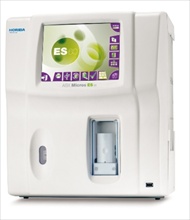Members Login

Channels
Special Offers & Promotions
HORIBA Medical in partnership with Spire Healthcare undertake haematology analyser comparison study
 Following its debut presentation at IBMS Congress 2011, the
results poster of the Spire Healthcare-commissioned granulocyte and neutrophil
count comparison study of HORIBA Medical's ABX Micros ES 60 and three other
methodologies is now available to view at the HORIBA
Medical-UK website. The study shows that the
granulocyte count of the ABX Micros ES 60 can be considered a neutrophil count
in the absence of flags, making it a suitable instrument for all Point-of-Care
(POC) settings. The neutrophil count is an important parameter in determining
the treatment of oncology and haematology patients.
Following its debut presentation at IBMS Congress 2011, the
results poster of the Spire Healthcare-commissioned granulocyte and neutrophil
count comparison study of HORIBA Medical's ABX Micros ES 60 and three other
methodologies is now available to view at the HORIBA
Medical-UK website. The study shows that the
granulocyte count of the ABX Micros ES 60 can be considered a neutrophil count
in the absence of flags, making it a suitable instrument for all Point-of-Care
(POC) settings. The neutrophil count is an important parameter in determining
the treatment of oncology and haematology patients. The aim of the study was to establish that the granulocyte count of a 3-part differential analyser (ABX Micros ES 60) correlates well when compared to the neutrophil count of other instruments and methodologies. Methodology involved the processing of 133 samples, less than four hours old, by a 5-part differential analyser (the HORIBA Medical ABX Pentra 80) and two 3-part differential analysers, the ABX Micros ES 60 and the PocH-100i (Sysmex). Manual differential counts were also performed and all results compared.
HORIBA Medical's ABX Micros ES 60 provides a rapid, laboratory standard full blood count with a 3-part differential. Combined with the ease of use, small footprint and CPA compliance, it is ideal for the POC environment. The analyser produces a granulocyte count, consisting of neutrophils, eosinophils and basophils. The neutrophils make up more than 95% of the granulocyte population and should, therefore, correlate well with neutrophil counts from other methodologies in the absence of flags alerting to elevated eosinophil or basophil levels.
Results from the comparison between the ABX Micros ES 60 and the PocH-100i showed excellent correlation where no flags were present, and good correlation where there were flags. Additionally, all the instruments involved showed good correlation for neutrophils/granulocytes, particularly in the absence of flags where there was little distinction between methodologies. The results from the study dispel any concerns a healthcare practitioner may have in using a 3-part differential instrument producing a granulocyte count, as opposed to a neutrophil count.
Working in partnership with good lines of communication has given rise to additional future opportunities for both HORIBA Medical and Spire Healthcare. "Having worked highly effectively with HORIBA Medical for the past year, we know that we can fully trust their haematology expertise and technology, so much so that we are now undertaking further joint R&D work," said Clive Woodford, Pathology Services Manager, Spire. "As part of our policy to always deliver service excellence to our customers, Spire Healthcare believes that undertaking applied R&D internally is one means of securing this. We are very pleased to be working jointly with HORIBA Medical in this area too."
The results of this comparison study can be viewed in detail at: www.horiba.com/uk/medical/feedback/poc-analyser-neutrophil-and-granulocyte-comparison-study
Media Partners


